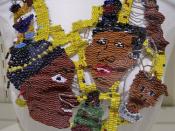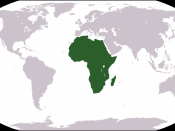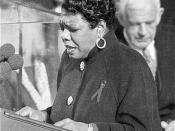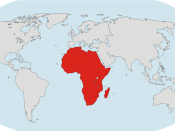Maya Angelou's "Africa" describes Africa being destroyed by Europeans who took the children of Africa into slavery. Personification and rhythm enhance both the imagery and tone of the poem. The continent of Africa is personified to create vivid images and the rhythmical patterns contribute to the changing tone from pleasant to unpleasant to contemplative.
Africa is personified to create vivid imagery and to give human emotions to a continent. Simultaneously, the entire poem is a metaphor of Africa as a beautiful woman. Africa is personified as a woman with "deserts her hair [...] / mountains her breasts / two Niles her tears" (3,6). The description creates vivid images of the land. In line 21, Africa "screams loud and vain." This personification and onomatopoeia suggest that the continent was devastated when people were taken from their homeland. Also, the words "she" and "her" are repeated throughout the poem. The continent is treated as a woman to empathize.
In line 24, which states "she is striding," the image of a confident stride suggests the resurrection of the country after "her history [was] slain" (23). Also, the continent is personified as a mother in lines 13-14 when the Europeans "took her young daughters / sold her strong sons." The comparison draws attention not to a beautiful resting woman, but to her rape and destruction.
The stanzas have three different tones through the rhythms of the meters. The tones move from pleasant to unpleasant to contemplative. The first and second stanzas contain dactyls followed by imperfect accented feet and trochees while the last stanza contains iambs and spondees. The dactylic meter imitates the sound of distant drums beating in Africa in the first stanza. The repetition of imperfect stressed feet at the end of lines in the second stanza suggests the disruption of an alien invasion on the African's lives when the Africans were taken as slaves. The cheerfulness of the "sugar cane sweet" (2) land is soon crushed by the "white seas / rime white and cold" (9-10) that introduce the second stanza. The "white seas [...] / icicle bold" (9-12) suggest a double entendre for the white Europeans. The seas evoke an unpleasant mood which also creates the second movement of tone. The rising meters, lines ending in stressed syllables, call attention not to the beautiful landscape, but to the rape and destroying of Africa. For example, the feet "took her young daughters / sold her strong sons" (13-14) are stressed on the last words to emphasize these young lives being destroyed. In line 18, a trochee changes the mood to a hopeful one because of the stress on the word "rising". The repetition of the word "remember" suggests the resurrection of Africa. The rising meters in the last stanza also emphasize the importance of remembering the past.
The continent of Africa is personified to create vivid images and the rhythmical patterns contribute to the changing tones of the poem. The tones move from cheerful to displeasing to reflective. The rhythm and three movement patterns enhance the changes in tone of the poem.





